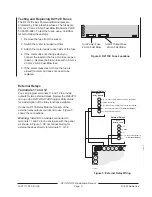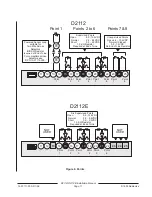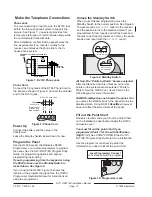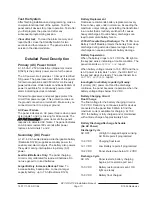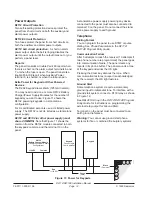
D2112/D2112E Installation Manual
Page 13
74-07111-000-D 1/96
© 1995 Radionics
Battery Replacement
Radionics recommends battery replacement every
three to five years under normal use. Exceeding the
maximum output ratings, or installing the transformer
in an outlet that is routinely switched off, causes
heavy discharges. Routine heavy discharges can
lead to premature battery failure.
D135A Prevents Deep Discharge: The D135A Low
Battery Cutoff Module protects the battery from deep
discharge during extended power outages. Deep
discharge can cause permanent battery damage.
Battery Supervision
When the battery drops to 12.1 VDC the OK light on
the keypad winks, indicating a trouble condition. The
panel transmits a
BATTERY LOW
report.
When battery voltage returns to 13.0 VDC and there
is AC power at terminals 1 and 2, the OK LIGHT at
the keypad stays on steady. The panel transmits a
BATTERY RESTORAL
report.
Investigate low battery reports right away:
If primary (AC) power is off and the discharge
continues, the panel becomes inoperative when the
battery voltage drops below 10.2 VDC.
Battery Charging Circuit
Float Charge
The float voltage for the battery charging circuit is
13.9 VDC. Deduct any continuous load for devices
connected to the panel from 860mA to find the
maximum current available for charging. At 13.9
VDC the battery is fully charged and is maintained
with a trickle charge of approximately 5mA.
Battery Discharge/Recharge Schedule
(No AC Power)
Discharge Cycle
AC OFF
OK light on keypad begins winking
AC Fail reports if programmed
13.9 VDC
Charging float level
12.1 VDC
Low Battery reports if programmed
10.2 VDC
Panel shuts down below 10.2 VDC
Recharge Cycle
AC ON
Panel restarts, battery charging
begins, AC restoral report sent
13.0 VDC
Battery restoral reports sent, OK
light on steady
13.9 VDC
Battery float charged
Test the System
After finishing installation and programming, make a
complete functional test of the system. Test the
panel and all devices for proper operation. Test after
you first program the panel and after any
subsequent programming session.
Clear after test: To clear the alarm memory and
report buffer, close the Standby Switch for two
seconds and then release it. The panel returns to
service in the disarmed state.
Detailed Panel Description
Primary (AC) Power Circuit
A 16.5 VAC, 25VA transformer (Radionics model
D1625) is the primary power source for the panel.
The AC power circuit provides 1.0 Amps of rectified
DC power. The panel reserves 140mA of this power
for internal operations and 350mA for continuously
powered devices. Under alarm conditions 860mA of
power is available for continuously powered and
alarm indicating devices combined.
Transient suppressors and spark gaps protect the
circuit from power surges. This protection relies on
the ground connection at terminal 3. Make sure you
connect terminal 3 to a proper ground.
AC Power Failure
The panel indicates an AC power failure when power
at terminals 1 and 2 is missing for 60 seconds. The
AC Fail Buzz/Rpt
AC Fail Buzz/Rpt
program item sets the panels
response to detected AC failure. The panel indicates
an AC power restoral 60 seconds after power
restores to terminals 1 and 2.
Secondary (DC) Power
A 12V, 4.0 Ah sealed lead-acid rechargeable battery
(Radionics D1240) supplies secondary power for
auxiliary and alarm outputs. The battery also powers
the system during interruptions in primary (AC)
power.
Lead Acid Batteries Only: The panel charging
circuit is only calibrated for lead-acid batteries. Do
not use gel-cell or nicad batteries.
Larger Battery Increases Backup Time: To
increase battery backup time, connect a larger
capacity battery, up to 7 Ah (Radionics D126).









